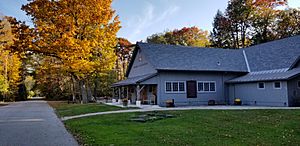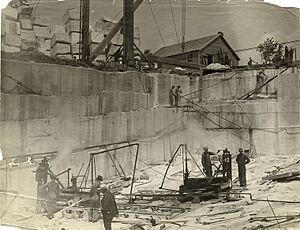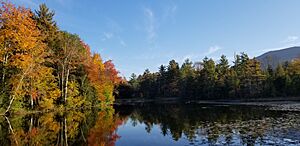Dorset, Vermont facts for kids
Quick facts for kids
Dorset, Vermont
|
|
|---|---|
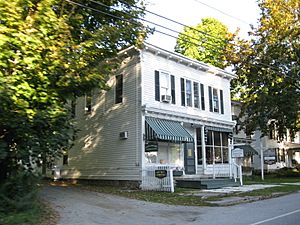 |
|
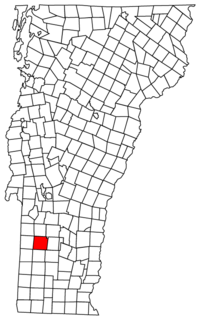
Dorset, Vermont
|
|
| Country | United States |
| State | Vermont |
| County | Bennington |
| Communities | Dorset East Dorset Freedleyville North Dorset South Dorset |
| Area | |
| • Total | 47.9 sq mi (124.0 km2) |
| • Land | 47.8 sq mi (123.7 km2) |
| • Water | 0.1 sq mi (0.3 km2) |
| Elevation | 1,302 ft (397 m) |
| Population
(2020)
|
|
| • Total | 2,133 |
| • Density | 45/sq mi (17.2/km2) |
| Time zone | UTC-5 (Eastern (EST)) |
| • Summer (DST) | UTC-4 (EDT) |
| ZIP codes |
05251 (Dorset)
05253 (East Dorset) |
| Area code | 802 |
| FIPS code | 50-17725 |
| GNIS feature ID | 1462082 |
Dorset is a town in Bennington County, Vermont, United States. In 2020, about 2,133 people lived here. Dorset is famous for its history. Important meetings were held at Cephas Kent's Inn, which helped create the independent Vermont Republic. This later led to Vermont becoming a state.
Dorset is also home to America's oldest marble quarry. It is the birthplace of Bill W., a very important person who helped many people. In East Dorset, you can find the Wilson House and the Griffith Library. The town is named after the English county of Dorset.
The marble quarry in East Dorset was started by Bill W.'s great-grandfather. It stayed in his family for three generations. Marble from these quarries was used to build the New York Public Library Main Branch in New York City. The quarry is now closed. In the summer, it's a popular place for swimming.
The main part of Dorset is called the Dorset census-designated place. In 2010, about 249 people lived there.
Contents
Dorset's Early History
Long ago, native tribes gave up their claims to large areas of land. The Governor of New Hampshire then gave out land grants. These lands were west of the Connecticut River. However, the Province of New York also claimed this land. This caused problems for settlers who had bought land from New Hampshire. New York tried to say that its claim was correct.
The land between New York and New Hampshire was always in dispute. New York said the land was part of a grant from Charles II in 1664. But New York had not tried to settle it. New Hampshire wanted to expand its area. So, it gave out 131 land charters in the territory. This area became known as the New Hampshire Grants.
New York then said these grants were not valid. They told settlers they had to buy the land again from New York. This new price was much higher. The New Hampshire Grantees formed a group called the "Green Mountain Boys". These civilian soldiers stopped settlers from being forced off their land.
To protect their land and families, the people of the New Hampshire Grants formed "Committees of Safety". These groups helped organize protection for their communities. They were formed eight years before similar groups in the 13 colonies.
Cephas Kent's Inn and Vermont's Birth
Cephas Kent was born in Connecticut. He moved to Dorset with his family in 1773. He was a church leader and owned a small tavern. This tavern became very important in Vermont's history. By 1775, the land dispute was serious. The Grantees decided to take official action. They held a big meeting at Cephas Kent's tavern.
At this meeting, they talked about their own land problems. They also discussed the larger cause of American independence. The Continental Congress wanted the Green Mountain Boys to join the fight. They asked for a regiment to be formed in the New Hampshire Grants. The Grantees wanted to join the rebellion. But they did not want to be part of New Hampshire or New York.
So, they asked the Continental Congress for help. They wanted to serve independently in the war. The Grantees met three more times at Cephas Kent's tavern. On June 25, 1776, they voted to ask the people of the Grants to form a separate district. Later that day, they promised to fight against the British. This was the first official step toward Vermont becoming independent.
The future state of Vermont began here. The town of Windsor also claims to be Vermont's birthplace. In Windsor, on July 2, 1777, Vermont's constitution was adopted. The state's name was also chosen there. But the idea for Vermont was born in Dorset, at Cephas Kent's tavern.
In 1790, New York finally gave up its claims. On February 18, 1791, Congress made Vermont the fourteenth state. In 1912, a historical marker was placed at the site of the Cephas Kent Inn in Dorset. The agreements made at Cephas Kent's tavern are known as the Dorset Accords.
Dorset's Geography
Dorset is located near the northern edge of Bennington County. Rutland County is to the north. The Taconic Mountains cover most of the western part of town. The Valley of Vermont is on the east side. This valley separates the Taconics from the Green Mountains to the east.
Communities like East Dorset, Freedleyville, and North Dorset are in the Valley of Vermont. They are along U.S. Route 7. Emerald Lake State Park is also in this area. Dorset and South Dorset are in the western and southern parts of town. They are along Vermont Route 30. These areas are in a valley between parts of the Taconic Range.
Mount Aeolus is 3,230 feet (980 m) tall. It is in the southern part of town. Dorset Mountain is in the northern part. Its highest point, Dorset Peak, is 3,770 feet (1,150 m) tall. This peak is just north of the town line in Danby. A slightly lower peak, 3,730 feet (1,140 m) tall, is located within Dorset itself.
The town covers about 47.9 square miles (124.0 km2). Most of this is land, about 47.8 square miles (123.7 km2). Only a small part, about 0.1 square miles (0.3 km2), is water. The highest point of land in the Valley of Vermont is in Dorset. This point divides the water flowing to the Hudson River and Lake Champlain.
The Batten Kill river starts just north of East Dorset. It flows south into Manchester. Then it goes west to the Hudson River in New York. The Otter Creek is one of Vermont's longest rivers. It starts a short distance north of the Batten Kill's source. It flows north through Emerald Lake and into Rutland County. It eventually reaches Lake Champlain north of Vergennes.
Dorset's Population
| Historical population | |||
|---|---|---|---|
| Census | Pop. | %± | |
| 1790 | 958 | — | |
| 1800 | 1,286 | 34.2% | |
| 1810 | 1,294 | 0.6% | |
| 1820 | 1,359 | 5.0% | |
| 1830 | 1,507 | 10.9% | |
| 1840 | 1,432 | −5.0% | |
| 1850 | 1,700 | 18.7% | |
| 1860 | 2,090 | 22.9% | |
| 1870 | 2,195 | 5.0% | |
| 1880 | 2,005 | −8.7% | |
| 1890 | 1,696 | −15.4% | |
| 1900 | 1,477 | −12.9% | |
| 1910 | 1,472 | −0.3% | |
| 1920 | 1,226 | −16.7% | |
| 1930 | 1,120 | −8.6% | |
| 1940 | 1,128 | 0.7% | |
| 1950 | 1,150 | 2.0% | |
| 1960 | 1,150 | 0.0% | |
| 1970 | 1,293 | 12.4% | |
| 1980 | 1,648 | 27.5% | |
| 1990 | 1,918 | 16.4% | |
| 2000 | 2,036 | 6.2% | |
| 2010 | 2,031 | −0.2% | |
| 2020 | 2,133 | 5.0% | |
| U.S. Decennial Census | |||
In 2000, Dorset had 2,036 people living in 856 households. About 27.1% of households had children under 18. The average household had 2.38 people. The average family had 2.82 people.
About 21.9% of the population was under 18. About 19.5% were 65 or older. The average age in Dorset was 45 years. For every 100 females, there were about 98.8 males.
Getting Around Dorset
Dorset has several main roads. These include US Route 7, VT Route 7A, and VT Route 30. Public transportation is available along US 7 and VT 7A. "The Bus" is run by the Marble Valley Regional Transit District. It travels from Rutland Monday through Saturday.
Famous People from Dorset
- William B. Bartlett, a state lawmaker from Wisconsin
- Dom DeLuise, a well-known actor and comedian
- Lorenzo Hatch, an engraver and artist
- W.C. Heinz, a war reporter and sports writer
- James Howe, a children's writer famous for the Bunnicula books
- John Irving, a novelist
- John Nassivera, an award-winning playwright, author, and professor
- Elizabeth Payson Prentiss, an author
- Theresa Rebeck, an award-winning Broadway and TV playwright
- Ellen Stimson, an author known for writing about life in Dorset
- Mark Whalon, a poet and author
- Treat Williams, a film actor
Dorset's Climate
Dorset has a climate with big temperature changes throughout the year. Summers are warm to hot and often humid. Winters are cold, sometimes very cold. This type of weather is called a humid continental climate.
See also
 In Spanish: Dorset (Vermont) para niños
In Spanish: Dorset (Vermont) para niños



